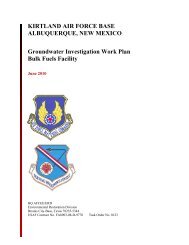Final FONSI and EA for hot cargo pad on Kirtland AFB - Kirtland Air ...
Final FONSI and EA for hot cargo pad on Kirtland AFB - Kirtland Air ...
Final FONSI and EA for hot cargo pad on Kirtland AFB - Kirtland Air ...
Create successful ePaper yourself
Turn your PDF publications into a flip-book with our unique Google optimized e-Paper software.
<str<strong>on</strong>g>Final</str<strong>on</strong>g> <str<strong>on</strong>g>EA</str<strong>on</strong>g> Addressing C<strong>on</strong>structi<strong>on</strong>, Operati<strong>on</strong>, <str<strong>on</strong>g>and</str<strong>on</strong>g> Maintenance of a Hot Cargo Pad<br />
Transportati<strong>on</strong> facilities provide <str<strong>on</strong>g>for</str<strong>on</strong>g> the movement of muniti<strong>on</strong>s materials <str<strong>on</strong>g>and</str<strong>on</strong>g> equipment to meet<br />
operating <str<strong>on</strong>g>and</str<strong>on</strong>g> missi<strong>on</strong> requirements. These facilities include <str<strong>on</strong>g>hot</str<strong>on</strong>g> <str<strong>on</strong>g>cargo</str<strong>on</strong>g> <str<strong>on</strong>g>pad</str<strong>on</strong>g>s, flight line muniti<strong>on</strong>s holding<br />
points, primary <str<strong>on</strong>g>and</str<strong>on</strong>g> alternate muniti<strong>on</strong>s movement routes, vehicle parking, <str<strong>on</strong>g>and</str<strong>on</strong>g> load <str<strong>on</strong>g>and</str<strong>on</strong>g> unload plat<str<strong>on</strong>g>for</str<strong>on</strong>g>ms<br />
(railheads) (USAF 2004). Basic design <str<strong>on</strong>g>and</str<strong>on</strong>g> safety st<str<strong>on</strong>g>and</str<strong>on</strong>g>ards <str<strong>on</strong>g>for</str<strong>on</strong>g> muniti<strong>on</strong>s transportati<strong>on</strong> facilities, such<br />
as <str<strong>on</strong>g>hot</str<strong>on</strong>g> <str<strong>on</strong>g>cargo</str<strong>on</strong>g> <str<strong>on</strong>g>pad</str<strong>on</strong>g>s, are provided in multiple USAF documents, including AFMAN 91-201, Explosives<br />
Safety St<str<strong>on</strong>g>and</str<strong>on</strong>g>ards; <strong>Air</strong> Force H<str<strong>on</strong>g>and</str<strong>on</strong>g>book (AFH) 32-1084, Facility Requirements; AFI 32-1021, Planning<br />
<str<strong>on</strong>g>and</str<strong>on</strong>g> Programming Military C<strong>on</strong>structi<strong>on</strong> (MILCON) Projects; <str<strong>on</strong>g>and</str<strong>on</strong>g> UFC 3-260-1, <strong>Air</strong>field <str<strong>on</strong>g>and</str<strong>on</strong>g> Heliport<br />
Planning <str<strong>on</strong>g>and</str<strong>on</strong>g> Design, am<strong>on</strong>g others. The USAF Muniti<strong>on</strong>s Facilities St<str<strong>on</strong>g>and</str<strong>on</strong>g>ards Guide summarizes the<br />
multitude of USAF regulati<strong>on</strong>s into a single document that provides planning, site selecti<strong>on</strong> guidance, <str<strong>on</strong>g>and</str<strong>on</strong>g><br />
design st<str<strong>on</strong>g>and</str<strong>on</strong>g>ards <str<strong>on</strong>g>for</str<strong>on</strong>g> muniti<strong>on</strong>s-related facilities (USAF 2004).<br />
USAF policy <strong>on</strong> explosives safety requires the following (USAF 2009):<br />
<br />
<br />
<br />
Provide the maximum possible protecti<strong>on</strong> to pers<strong>on</strong>nel <str<strong>on</strong>g>and</str<strong>on</strong>g> property, both inside <str<strong>on</strong>g>and</str<strong>on</strong>g> outside the<br />
installati<strong>on</strong>, from the damaging effects of potential accidents involving ammuniti<strong>on</strong> <str<strong>on</strong>g>and</str<strong>on</strong>g><br />
explosives<br />
Comply with the cardinal principle <str<strong>on</strong>g>for</str<strong>on</strong>g> explosives safety: Expose the minimum number of people<br />
to the minimum amount of explosives <str<strong>on</strong>g>for</str<strong>on</strong>g> the minimum amount of time<br />
Compliance with AFMAN 91-201 except when compliance with more restrictive local st<str<strong>on</strong>g>and</str<strong>on</strong>g>ards<br />
is m<str<strong>on</strong>g>and</str<strong>on</strong>g>atory by an internati<strong>on</strong>al agreement.<br />
Design criteria <str<strong>on</strong>g>for</str<strong>on</strong>g> <str<strong>on</strong>g>hot</str<strong>on</strong>g> <str<strong>on</strong>g>cargo</str<strong>on</strong>g> <str<strong>on</strong>g>pad</str<strong>on</strong>g>s include the following (USAF 1996, DOD 2008):<br />
<br />
<br />
<br />
<br />
<br />
The <str<strong>on</strong>g>pad</str<strong>on</strong>g> must be located to satisfy explosives safety st<str<strong>on</strong>g>and</str<strong>on</strong>g>ards as prescribed in DOD Directive<br />
6055.9-STD, DOD Ammuniti<strong>on</strong> <str<strong>on</strong>g>and</str<strong>on</strong>g> Explosives Safety St<str<strong>on</strong>g>and</str<strong>on</strong>g>ards, <str<strong>on</strong>g>and</str<strong>on</strong>g> AFMAN 91-201.<br />
Medium-load pavement must be used <str<strong>on</strong>g>for</str<strong>on</strong>g> the <str<strong>on</strong>g>pad</str<strong>on</strong>g> <str<strong>on</strong>g>and</str<strong>on</strong>g> its access taxiway.<br />
Tiedown anchors <str<strong>on</strong>g>and</str<strong>on</strong>g> grounding points in the <str<strong>on</strong>g>pad</str<strong>on</strong>g> must be installed.<br />
Blue, flush-type taxiway lights around the edge of the <str<strong>on</strong>g>pad</str<strong>on</strong>g>s must be provided in accordance with<br />
AFI 32-1044, Visual <strong>Air</strong> Navigati<strong>on</strong> Systems, <str<strong>on</strong>g>and</str<strong>on</strong>g> AFMAN 32-1076, Design St<str<strong>on</strong>g>and</str<strong>on</strong>g>ards <str<strong>on</strong>g>for</str<strong>on</strong>g> Visual<br />
<strong>Air</strong> Navigati<strong>on</strong> Facilities.<br />
An access taxiway must be provided <str<strong>on</strong>g>for</str<strong>on</strong>g> access from the primary taxiway to the hazardous <str<strong>on</strong>g>cargo</str<strong>on</strong>g><br />
<str<strong>on</strong>g>pad</str<strong>on</strong>g>. The taxiway should be designed <str<strong>on</strong>g>for</str<strong>on</strong>g> the aircraft to taxi into the hazardous <str<strong>on</strong>g>cargo</str<strong>on</strong>g> <str<strong>on</strong>g>pad</str<strong>on</strong>g> under<br />
its own power.<br />
Per AFH 31-1084 <str<strong>on</strong>g>and</str<strong>on</strong>g> the USAF Muniti<strong>on</strong>s Facilities St<str<strong>on</strong>g>and</str<strong>on</strong>g>ards Guide, paved shoulders are included in<br />
<str<strong>on</strong>g>hot</str<strong>on</strong>g> <str<strong>on</strong>g>cargo</str<strong>on</strong>g> <str<strong>on</strong>g>pad</str<strong>on</strong>g> c<strong>on</strong>structi<strong>on</strong> as shown in Figure 3-9. Paved shoulders are authorized when it is necessary<br />
to protect the shoulder areas against jet blast; reduce maintenance of the unpaved shoulder area; support<br />
aircraft outrigger gear; or accommodate snow removal equipment, aircraft service vehicles, <str<strong>on</strong>g>and</str<strong>on</strong>g><br />
emergency vehicles (USAF 1996). Paved shoulders also provide locati<strong>on</strong>s <str<strong>on</strong>g>for</str<strong>on</strong>g> lighting <str<strong>on</strong>g>and</str<strong>on</strong>g> c<strong>on</strong>trol of<br />
FOD. Paved shoulders should be a minimum 10 feet (3.1 meters) wide with lights installed. Wider<br />
shoulders are required <str<strong>on</strong>g>for</str<strong>on</strong>g> wide-bodied aircraft (USAF 2004).<br />
Kirtl<str<strong>on</strong>g>and</str<strong>on</strong>g> <strong>AFB</strong>, NM January 2011<br />
3-38
















